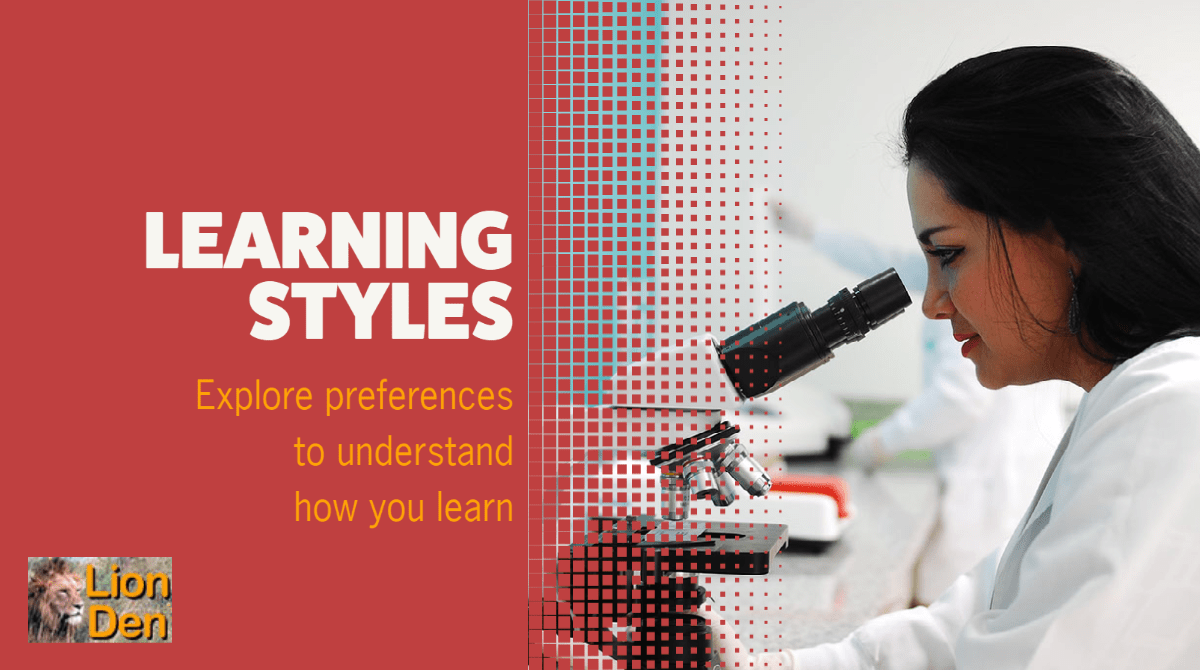Study Tips & Tools
Learning Styles
A tool to develop metacognition skills
Do you learn best by hearing it, seeing it, feeling it, reading about it? Then start out planning your learning activities to suit your style—it may help you better understand how you learn and make learning more fun.

Your learning style is your preferred way of learning new things. But keep in mind that it’s a preference. Your learning style simply gets you “thinking about your thinking”—a process called metacognition. By exploring your preferences, you may make better choices about how to learn and study.
For example, I like to SEE new concepts visualized for me in a drawing. So when I learn about a new physiological process, I like to see a diagram that shows me how it works. For me, that’s better than listening to someone explain it.
And I like to have my HANDS ON things as I learn about them. Of course, this works well in science labs.
So you see, I have more than one learning style—many of us do. Learners with more than one strong preference are called “multimodal” because they learn well in different modes, not just one.
Because learning styles are preferences, they help you identify your comfort zone of learning. But learning styles in no way place limits on how you can learn. Nearly all of us learn using any of the various modes of learning. Therefore, if your learning style is to explore things visually, that does not mean you cannot learn just as easily by hearing or reading—even if those styles are not the most comfortable for you. Sometimes, discomfort may actually improve learning by nudging you to focus more on the task and struggle to understand it fully.
Learning styles are not magic bullets. And they are not limitations. They are a simple tool to help you understand your own approach to learning.
Using learning styles to assist your metacognition about studying is controversial. That’s because some educators and students use them incorrectly—by putting students into a boxed-in category. When used this way, they have not been proven to work. Some claim this “debunks the learning style myth.”
However, when learning styles are used as a set of overlapping and interconnected preferences, they can help you develop metacognition skills. They do this by giving you different ways of looking at how you like to learn and that can help you sort out what’s working well for you and what isn’t. They are potential tools for gaining competence in metacognition, which is is the main goal. The key is to avoid locking yourself into any learning style and remember that we can all learn in multiple styles.
How can you figure out what your style is? The easiest way is to simply think of how you’ve learned things in the past and what worked best for you. Another easy way is to take the free VARK online quiz by visiting www.vark-learn.com.
VARK is an acronym that stands for :
V = Visual (learning by seeing)
A = Aural (learning by hearing)
R = Reading/writing (learning by reading and writing)
K = Kinesthetic (learning by touching or holding or feeling)
Once you’ve determined your style, you can choose ways to study that fit your style best. For example, a visual learner will benefit by drawing diagrams (see my hint on this) whereas a more aural learner might do better by listening tapes of the classroom discussion.
|
The www.vark-learn.com website has some Visual Study Strategies (V)
Aural Study Strategies (A) Read/write Study Strategies (R) Kinesthetic Study Strategies (K) Multimodal Study Strategies (MM) |
|---|
Another useful way of looking at learning styles is to determine whether you are:
an ACTIVE learner or REFLECTIVE learner
a SENSING or INTUITIVE learner
a VISUAL or VERBAL learner
a SEQUENTIAL or GLOBAL learner
|
To take a free test to determine your learning style using the scheme above, try this: Index of Learning Styles Questionnaire For detailed strategies for the different learning styles just described, try this: Strategies based on learning styles
|
It’s important to remember that your learning style is your PREFERENCE. It is NOT A LIMIT on the ways in which you can study. I happen to be a strong visual/kinesthetic learner but I frequently (and easily) learn things by reading about them. There is no one best style to have and there is no particular advantage of having any one learning style.
The best way to use learning styles is to help you choose from among a variety of available learning options.
Last updated: August 21, 2022 at 11:18 am